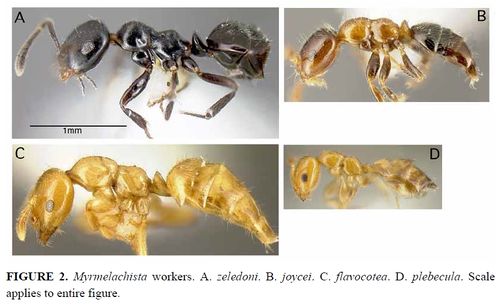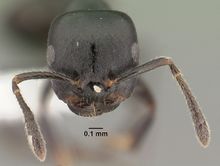Key to Myrmelachista workers of Costa Rica
This worker key is based on: Longino, J.T. 2006. A taxonomic review of the genus Myrmelachista in Costa Rica. Zootaxa. 1141:1-54.
Longino stated the following about Worker characters:
Workers show a great deal of plasticity and are not easily separated to species. There is inter- and intracolony size variation, and larger workers tend to exhibit more differences among species than small workers.
The only sharply defined character with two discrete states is the number of antennal segments: 9 or 10. All other characters are continuous, with each species showing a mean and a variance, overlapping with similar species, but not encompassing the entire range of variation. The maxillary palpus may be 5-segmented, 6-segmented, or both. In some cases the terminal palpomere is elongate and there is a slight constriction in the middle, suggesting partial fusion of the terminal two palpomeres. In some cases within a species (e.g., plebecula) colonies with small workers have 5 segments, colonies with larger workers have 6. There are occasional individual specimens with one 5-segmented palpus and one 6-segmented palpus.
Mandible sculpture varies from smooth and shining to coarsely punctatorugose.
Pilosity patterns are quite variable but show trends within species. In full face view, pilosity on the side and rear margins may be sparse or abundant, very short or longer, about the length of the first funicular segment, fully appressed to suberect. Among the Costa Rican species pilosity on the scapes is always abundant and suberect to subdecumbent, and I have not found it useful for identification. The pilosity on the outer margin of the hind tibia is always present as a covering of short setae of relatively uniform length, with variable presence of longer setae projecting above them. The setae may look rather uniform and short, with length about 1/4 width of tibia, or they may be longer and somewhat more irregular, the longer setae being 1/2 to 3/4 tibia width. The setae may be fully appressed to suberect.
Color is a useful character. A set of seven species that have become obligate inhabitants of live stems of particular species of Lauraceae and Meliaceae have a uniform light yellow orange color, with variable development of infuscated bands on the gastral terga. Six species that are more generalized in their nesting habits and more often forage on the surface have largely brown coloration, with variable development of mottling of the mesosoma. Problematic cases are when workers are bicolored, with light colored head and mesosoma and dark colored gaster. Myrmelachista plebecula, one of the surface foraging species, can approach the coloration of the some of the yellow species.
I have rarely found useful characters in the shape of the mesosoma or petiole, although the species with 10-segmented antenna have a stronger hourglass shape, with strong constriction at the metanotal groove.
You may also be interested in
- Myrmelachista
- Key to Myrmelachista queens of Costa Rica
- Key to Myrmelachista males of Costa Rica
- Costa Rica
1
- Antenna with 10 segments; mesosoma strongly hourglass-shaped, with strong constriction at metanotal groove (Fig. 2); color dark brown to black . . . . . 2
- Antenna with 9 segments; mesosoma not strongly hourglass-shaped, moderately constricted at metanotal groove; color variable, from yellow orange to red brown to black . . . . . 3
2
return to couplet #1
- Surface of head and mesosoma shagreened; HW greater than 0.50mm . . . . . Myrmelachista zeledoni
- Surface of head and much of mesosoma smooth and shiny; HW less than 0.48mm . . . . . Myrmelachista mexicana
3
return to couplet #1
- Color nearly uniform light yellow orange or with some degree of infuscation on gaster (Fig. 2C); if clearly bicolored with orange head and mesosoma and dark gaster, pubescence on sides of head and on hind tibia usually abundant, suberect, OI usually less than 22 . . . . . 4
- Color black to red brown, usually either uniform red brown or with dark head and gaster and mottled light and dark brown mesosoma (Fig. 2B); if clearly bicolored, pubescence on sides of head very sparse and fully appressed, pilosity on hind tibia fully appressed, and OI greater than 21 . . . . . 10
4
return to couplet #3
- Maxillary palpus always 6-segmented; HW of larger workers usually greater than 0.65mm. . . . . . 5
- Maxillary palpus always 5-segmented; HW of larger workers usually less than 0.65mm (the following set of species cannot be reliably distinguished with workers but can be differentiated with queens). . . . . . . 6
5
return to couplet #4
- Infuscation of gastral tergites weak, confined to posterior third or less of tergites; nests in live stems of various plants in southern mountains of Costa Rica . . . . . Myrmelachista meganaranja
- Infuscation of gastral tergites more extensive, dark brown and covering 2/3 or more of tergite; nests in one species of understory Guarea in Cordillera de Tilarán, Costa Rica . . . . . Myrmelachista flavoguarea
6
return to couplet #4
- Gastral tergites completely yellow, without posterior band of infuscation; hind tibia with suberect pilosity . . . . . 7
- Gastral tergites with variably developed infuscated band posteriorly; hind tibia with suberect or appressed pilosity. . . . . . 8
7
return to couplet #6
- Head of larger workers relatively broad (Fig. 4), CI 98–103; Atlantic slope . . . . . Myrmelachista flavocotea
- Head of larger workers relatively narrow, CI 87–95; southern Pacific slope . . . . . Myrmelachista lauropacifica
8
return to couplet #6
- Hind tibia with pilosity fully appressed . . . . . Myrmelachista nigrocotea
- Hind tibia with pilosity subdecumbent to suberect . . . . . 9
9
return to couplet #8
- Side of head with projecting erect setae, the longest of which are similar in length to length of first funicular segment; Atlantic slope . . . . . Myrmelachista lauroatlantica
- Side of head with projecting setae subdecumbent, very short, much shorter than length of first funicular segment; montane areas and southern Pacific lowlands . . . . . Myrmelachista haberi / Myrmelachista osa
10
return to couplet #3
- Color solid black; clypeus bulging; mandible with teeth 4 and 5 (counting from apex) separated by a wide diastema, teeth 1–4 more closely and evenly spaced; HW of larger workers 0.75mm or greater . . . . . Myrmelachista cooperi
- Color variable; clypeus not strongly bulging; mandible without diastema between teeth 4 and 5, all 5 teeth relatively evenly spaced; HW of larger workers usually less than about 0.70mm . . . . . 11
11
return to couplet #10
- Head relatively elongate and subrectangular (Fig. 5), CI 89–95; mandible punctatorugose; sides of head with pubescence sparse and very short, subdecumbent to fully appressed . . . . . Myrmelachista longiceps
- Head relatively shorter, often somewhat cordate, CI 92–107; mandible usually smooth and shining; pubescence on side of head variable, from sparse and fully appressed to abundant and suberect (workers of plebecula and joycei cannot always be distinguished) . . . . . 12
12
return to couplet #11
- Often bicolored, with light red brown head and mesosoma, dark gaster, but may have same coloration as joycei; pubescence on side of head usually sparse, short, fully appressed; pilosity on hind tibia usually appressed; eyes relatively larger, OI 22–25; HW of larger workers usually less than about 0.53mm (Fig. 5) . . . . . Myrmelachista plebecula
- Never bicolored (except nanitics), head and gaster dark brown, mesosoma variably mottled light and dark red brown; pubescence on side of head and hind tibia subdecumbent; eyes relatively smaller, OI 19–21; HW of larger workers often greater than 0.53mm . . . . . Myrmelachista joycei




























